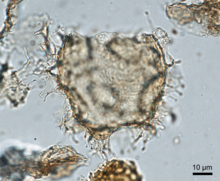Extinct genus of dinoflagellate cysts
| Palynodinium | |
|---|---|

| |
| Bright-field photomicrograph of Palynodinium grallator produced by Sandy McLachlan, University of Victoria from the Oyster Bay Formation of eastern Vancouver Island. | |
| Scientific classification | |
| Domain: | Eukaryota |
| Clade: | Diaphoretickes |
| Clade: | SAR |
| Clade: | Alveolata |
| Phylum: | Myzozoa |
| Superclass: | Dinoflagellata |
| Class: | Dinophyceae |
| Order: | Gonyaulacales |
| Family: | †Areoligeraceae |
| Genus: | †Palynodinium H.Gocht, 1970 |
Palynodinium is an extinct genus of organic-walled dinoflagellate cyst (or dinocyst). It is a fossil species of dinoflagellate cyst used to demarcate the K/Pg boundary, which marks the terminal Cretaceous and the extinction of the dinosaurs. Palynodinium grallator was among the microfossils which lead to the recent discovery of the K/Pg event record in marine sediments of the northeast Pacific.
Dinoflagellate cysts are estimated to be produced by 10–16% of living dinoflagellates as a dormant, zygotic stage of their life cycle, which can accumulate in marine sediments as microfossils. Organic-walled dinoflagellate cysts are noted for their resistance to degradation owing to their composition of dinosporin, a biopolymer similar to sporopolinin characteristic of many terrestrial palynomorphs. Their abundance, cosmopolitan distribution, and quality of preservation in the fossil record since the Middle Triassic make dinoflagellate cysts excellent indicators of primary productivity as well as tools for biostratigraphy and paleoenvironmental reconstructions. The scope of dinoflagellate cyst applications has resulted in ongoing collaborative efforts between industry and academia to refine their taxonomic classification and enhance their utility through database organization.
References
- Beaudoin, Alwynne Bowyer; Head, M. J.; Head, Martin J. (2004). The Palynology and Micropalaeontology of Boundaries. p. 261. ISBN 9781862391604.
- Head, M.J., 1996. Modern dinoflagellate cysts and their biological affinities, in: Jansonius, J., McGregor, D.C. (Eds.), Palynology: Principles and Applications. Association of Stratigraphic Palynologists Foundation, pp. 1197–1248.
- Askin, Rosemary A.; Jacobson, Stephen R. (1 January 2003), "Palynology", in Meyers, Robert A. (ed.), Encyclopedia of Physical Science and Technology (Third Edition), New York: Academic Press, pp. 563–578, ISBN 978-0-12-227410-7, retrieved 8 May 2022
- Fensome, R.A., Taylor, F.J.R., Norris, G., Sarjeant, W. A. S., Wharton, D.I., Williams, G.L., 1993. A classification of fossil and living dinoflagellates. Micropaleontol. Press Spec. Pap. 7, 1–351.
- Bogus, K., Mertens, K.N., Lauwaert, J., Harding, I.C., Vrielinck, H., Zonneveld, K.A.F., Versteegh, G.J.M., 2014. Differences in the chemical composition of organic-walled dinoflagellate resting cysts from phototrophic and heterotrophic dinoflagellates. J. Phycol. 50, 254–266.
- Fensome, R.A., MacRae, J.M., Moldowan, F.J.R., Williams, G.L., 1996. The early Mesozoic radiation of dinoflagellates. Paleobiology 22, 329–338.
- Riding, J.B., Mantle, D.J., Backhouse, J., 2010. A review of the chronostratigraphical ages of Middle Triassic to Late Jurassic dinoflagellate cyst biozones of the North West Shelf of Australia. Rev. Palaeobot. Palynol. 162, 543–575.
- Dale, B., 1996. Dinoflagellate cyst ecology: Modeling and geological applications, in: McGregor, J.J.& D.C. (Ed.), Palynology: Principles and Applications. American Association of Stratigraphic Palynologists Foundation, Dallas, pp. 1249–1276.
- Pospelova, V., de Vernal, A., Pedersen, T.F., 2008. Distribution of dinoflagellate cysts in surface sediments from the northeastern Pacific Ocean (43-25°N) in relation to sea-surface temperature, salinity, productivity, and coastal upwelling. Mar. Micropaleontol. 68, 21–48.
- Stover, L.E., Brinkhuis, H., Damassa, S.P., Verteuil, L. De, Helby, R.J., Monteil, E., Partridge, A.D., Powell, A.J., Riding, J.B., Sllleiror, M., Williallls, G.L., 1996. Mesozoic–Tertiary dinoflagellates, acritarchs, and prasinophytes, in: Palynology: Principles and Applications. Association of Stratigraphic Palynologists Foundation, Dallas, pp. 641–750.
- Bowman, V.C., Francis, J.E., Riding, J.B., 2013. Late Cretaceous winter sea ice in Antarctica? Geology 41, 1227–1230.
- Williams GL, Fensome R, MacRae RA. 2017. DINOFLAJ3. American Association of Stratigraphic Palynologists, Data Series No 2.http://dinoflaj.smu.ca/dinoflaj3/index.php/Palynodinium_grallator
- Bijl, Peter K. (2022). "DINOSTRAT: A global database of the stratigraphic and paleolatitudinal distribution of Mesozoic–Cenozoic organic-walled dinoflagellate cysts". Earth System Science Data. 14 (2): 579–617. Bibcode:2022ESSD...14..579B. doi:10.5194/essd-14-579-2022. S2CID 246746360.
| Taxon identifiers | |
|---|---|
| Palynodinium | |